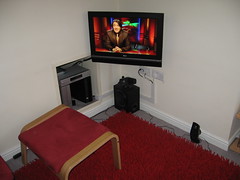I’m very excited to be welcoming another Hursley innovator as a guest here on eightbar – Benjamin Hardill (you can find him on Twitter as @hardillb). Here’s some insight into what he’s been up to lately! More home automation, hardware hacking, and MQTT messaging adventures follow 🙂
I got a new TV around Christmas last year and while unpacking it I noticed along with the HDMI, SCART and other sockets on the back it had a 9-pin socket labelled "RS232C IN CONTROL&SERVICE". I didn’t think that much of it at the time, but I remembered it last week while thinking about a couple of problems that had come up.
 The first of these was that I had got home twice recently to find I’d left the TV turned on while I was at work, this was mainly because I use MythTV and I’d left it at the menu screen rather than turning the screen off as well. This had left shadow on the menu on the screen for a day or so afterwards (luckily no permanent damage as would have happened with a plasma or CRT TV).
The first of these was that I had got home twice recently to find I’d left the TV turned on while I was at work, this was mainly because I use MythTV and I’d left it at the menu screen rather than turning the screen off as well. This had left shadow on the menu on the screen for a day or so afterwards (luckily no permanent damage as would have happened with a plasma or CRT TV).
The other point was from when we all first got hold of our Current Cost meters, there had been a lot of thought about how to work out exactly what appliances were on at any given time. While spotting when things like an electric water heater turned on was relatively easy, it was proving difficult to spot some of the lower power devices.
A plan started to form and I ordered a null modem cable from Amazon (£2.18 with free shipping) and went looking for some documentation on the protocol. The manual that came with the TV while being nearly an inch thick just covers the basics of how to plug it in and turn it on, but there was a CD-ROM with a much more detailed PDF document. The version for my TV is here. While searching round I found manuals for several other LG LCD/plasma TVs and they all seem to use the same basic protocol.
The protocol is relatively simple
[cmd1][cmd2] [setid] [data]
Where the cmd1 & cmd2 are 1 letter code, setid is for if you have multiple TVs connected to the same cable, the default id is 01 but you can change if needed, using 00 will work for all connected TVs. And data is a hex value of the option to pass the command.
The response from the TV looks like this for a success
[cmd2] [setid] OK[data]x
and like this for a failure
[cmd2] [setid] NG[data]x
The command to turn the TV on and off is "ka" so sending
ka 00 1
turns the TV on and sending
ka 00 0
turns it off. Most of the commands will reply with the current status if they are passed ff as the data. So sending
ka 00 ff
gets the following when the TV is off
a 00 OK0x
So now I had a way to turn the TV on and off along with checking its current status. The next step was to surface this some way and given the fascination we all seem to have with messaging, MQTT seemed like a good idea. A little bit of Java and the Java COMM API later and I had 2 topics TV/Commands & TV/Status.
I already have a topic that publishes if my mobile phone is in the flat by pinging it with Bluetooth. Combining this with the two new topics I can ensure that the TV is turned off when I leave. I’m also wondering if I should start to log the amount of time the TV is on, but I think the results may scare me a little…
